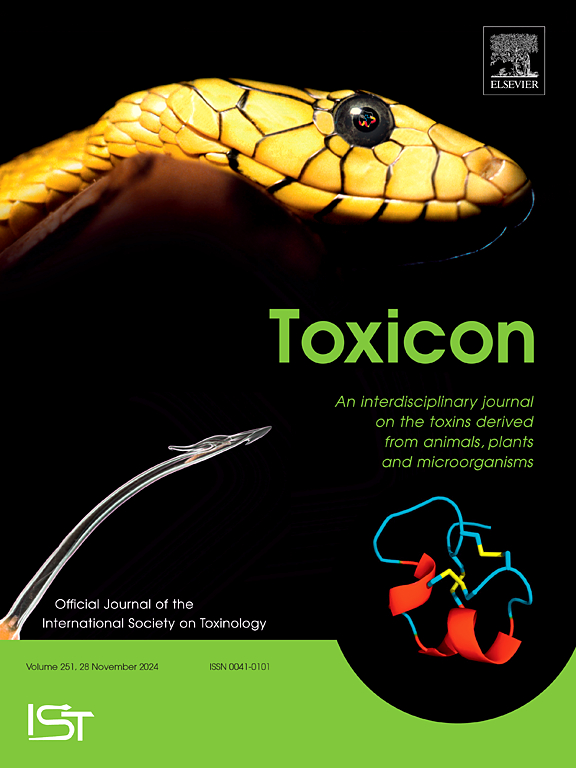The impact of lethal and sub-lethal exposure of emamectin benzoate on populations of Spodoptera litura (Lepidoptera: Noctuidae) under laboratory conditions
IF 2.6
4区 医学
Q2 PHARMACOLOGY & PHARMACY
引用次数: 0
Abstract
Emamectin benzoate is an avermectin bio-insecticide commonly used for managing several insect pests including Spodoptera litura (Fabricius) (Lepidoptera: Noctuidae), a major polyphagous pest of many cultivated crops. The current study was conducted to evaluate the effects of emamectin benzoate on the fitness of S. litura populations exhibiting differential susceptibility to insecticide. The selection process and all the bioassays were carried out using 6-day-old 2nd instar larvae of S. litura. A field-collected population of S. litura was divided into two groups: one selected with emamectin benzoate for eight generations (EB-Sel) and the other kept unexposed (Unsel-Lab) to insecticide in the laboratory. An increase in resistance ratio from 1.71-fold in the F1 generation to 22.54-fold in the F8 generation of the EB-Sel population was observed compared to the Unsel-Lab (F8) population. The EB-Sel and Unsel-Lab populations were treated with their respective lethal and sub-lethal concentrations which resulted in an extended development period, decreased larval survival, and adult emergence along with increased morphological abnormalities in adults. Significant reductions were observed in both male and female longevity, fecundity, egg hatching, net reproductive rate (R0), intrinsic rate of increase (rm), and finite rate of increase (λ) in EB-Sel and Unsel-Lab populations. Higher concentrations of the insecticide also reduced the relative fitness (Rf) of S. litura larvae, with maximum effect at LC50 of the EB-Sel population where the Rf value was 0.32 compared to the Unsel-Lab population. Both populations have been affected by emamectin benzoate exposure, however, the impact was more pronounced in the EB-Sel population indicating fitness costs. Our results suggested the fitness cost linked to emamectin benzoate resistance in S. litura which might favor managing insecticide resistance by reducing the frequency of resistant alleles by removing selection pressure. Consequently, our research provides significant insights to devise better pest management strategies for S. litura.

在实验室条件下,苯甲酸阿维菌素致死和亚致死暴露对斑翅蝶类(鳞翅目:夜蛾科)种群的影响。
苯甲酸阿维菌素是一种阿维菌素生物杀虫剂,常用于防治多种害虫,包括许多栽培作物的主要多食性害虫 Spodoptera litura (Fabricius) (鳞翅目:夜蛾科)。本研究旨在评估苯甲酸阿维菌素对表现出对杀虫剂不同敏感性的 S. litura 种群的适应性的影响。选择过程和所有生物测定都是使用 6 天大的 S. litura 二龄幼虫进行的。田间采集的 S. litura 群体被分为两组:一组用苯甲酸阿维菌素选育了八代(EB-Sel),另一组在实验室中未接触杀虫剂(Unsel-Lab)。与Unsel-Lab(F8)群体相比,EB-Sel群体的抗药性比率从F1代的1.71倍增加到F8代的22.54倍。对 EB-Sel 和 Unsel-Lab 种群分别使用致死浓度和亚致死浓度进行处理,结果导致发育期延长、幼虫存活率降低、成虫出现以及成虫形态异常增加。在 EB-Sel 和 Unsel-Lab 种群中,雄性和雌性的寿命、繁殖力、卵孵化率、净生殖率 (R0)、内在增长率 (rm) 和有限增长率 (λ)均显著降低。较高浓度的杀虫剂也会降低 S. litura 幼虫的相对适合度(Rf),EB-Sel 种群在 LC50 时的影响最大,与 Unsel-Lab 种群相比,其 Rf 值为 0.32。两个种群都受到了苯甲酸阿维菌素暴露的影响,但是,EB-Sel 种群受到的影响更为明显,这表明了适应性成本。我们的研究结果表明,在 S. litura 中,苯甲酸阿维菌素抗性会带来适应性成本,这可能有利于通过消除选择压力来降低抗性等位基因的频率,从而管理杀虫剂抗性。因此,我们的研究为制定更好的 S. litura 害虫管理策略提供了重要启示。
本文章由计算机程序翻译,如有差异,请以英文原文为准。
求助全文
约1分钟内获得全文
求助全文
来源期刊

Toxicon
医学-毒理学
CiteScore
4.80
自引率
10.70%
发文量
358
审稿时长
68 days
期刊介绍:
Toxicon has an open access mirror Toxicon: X, sharing the same aims and scope, editorial team, submission system and rigorous peer review. An introductory offer Toxicon: X - full waiver of the Open Access fee.
Toxicon''s "aims and scope" are to publish:
-articles containing the results of original research on problems related to toxins derived from animals, plants and microorganisms
-papers on novel findings related to the chemical, pharmacological, toxicological, and immunological properties of natural toxins
-molecular biological studies of toxins and other genes from poisonous and venomous organisms that advance understanding of the role or function of toxins
-clinical observations on poisoning and envenoming where a new therapeutic principle has been proposed or a decidedly superior clinical result has been obtained.
-material on the use of toxins as tools in studying biological processes and material on subjects related to venom and antivenom problems.
-articles on the translational application of toxins, for example as drugs and insecticides
-epidemiological studies on envenoming or poisoning, so long as they highlight a previously unrecognised medical problem or provide insight into the prevention or medical treatment of envenoming or poisoning. Retrospective surveys of hospital records, especially those lacking species identification, will not be considered for publication. Properly designed prospective community-based surveys are strongly encouraged.
-articles describing well-known activities of venoms, such as antibacterial, anticancer, and analgesic activities of arachnid venoms, without any attempt to define the mechanism of action or purify the active component, will not be considered for publication in Toxicon.
-review articles on problems related to toxinology.
To encourage the exchange of ideas, sections of the journal may be devoted to Short Communications, Letters to the Editor and activities of the affiliated societies.
 求助内容:
求助内容: 应助结果提醒方式:
应助结果提醒方式:


